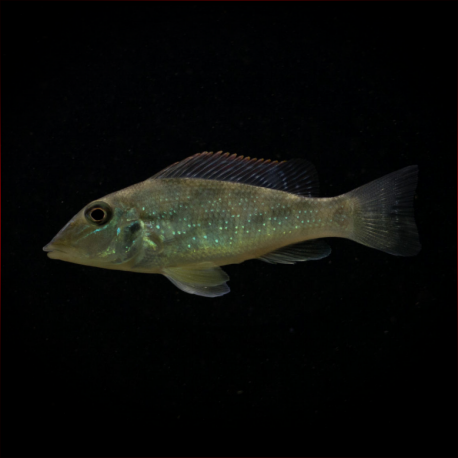More info
Datasheet
| Minimum Tank Size | 750 litres / 198.13 US gallons |
| Maximum Size | 20.0cm / 7.87inches |
| Temperature | 26°C / 78.80°F - 32°C / 89.60°F |
| Hardness | 1.01dgH / 18ppm - 12.05dgH / 215ppm |
| pH | 6.0-8.0 |
Behaviour
Retroculus Lapidifer is relatively peaceful except during breeding periods when it may prey on smaller tankmates. It is recommended to house them with peaceful pelagic fishes rather than other benthic species, especially in smaller aquaria. These cichlids are sociable and typically form loose aggregations outside of reproductive periods. Juveniles exhibit strong grouping instincts, and it is advised to purchase a group of 5-8 individuals to establish a noticeable dominance hierarchy. In smaller numbers, weaker specimens may be subjected to excessive antagonism, or the group may exhibit nervous behavior if not adequately settled.
Feeding and Diet
In the wild, Retroculus Lapidifer predominantly feeds on benthic aquatic invertebrates such as chironomid, trichoptera, and ephemeroptera larvae. In an aquarium setting, their diet should consist of high-quality prepared foods, live or frozen chironomid larvae, Tubifex, Artemia, Gammarus, mosquito larvae, and small earthworms. It is crucial to include dried products rich in vegetable matter like Spirulina. Offering 3-5 small meals per day rather than a single large portion promotes optimal growth and condition. While primarily benthivorous, these cichlids also readily consume items suspended in the water flow and small fishes.
Aquarium Setup
For Retroculus spp., an aquarium setup resembling a flowing river is ideal. The tank should have soft sand mixed with small pebbles, rocks, boulders, roots, branches, and hardy aquatic plants. Water quality is crucial, so maintaining spotless conditions and high dissolved oxygen levels is necessary. Adequate water movement with powerheads and pumps, as well as a linear flow pump, is recommended. Weekly water changes of 30-70% are vital, especially since wild specimens can be sensitive post-import, requiring an extended quarantine period.
Reproduction & Dimorphism
Retroculus Lapidifer is a biparental substrate-spawner that can be successfully bred in aquarium settings. Reproduction does not seem to have a specific trigger, but a good diet and strict maintenance routine with frequent water changes are essential. Sexually mature individuals may take up to two years to breed, with courtship initiated by the male before egg deposition. Male and female pairs excavate pits in the substrate for spawning, with the female laying adhesive eggs fertilized by the male. Adhesive eggs are covered with sand grains and later with small pebbles or debris. Males exhibit territorial displays, and mature males are slimmer than females with enlarged ventral fins.
Habitat and Distribution
Retroculus Lapidifer is a rheophilic species found in rapids and fast-flowing stretches of clear water rivers. Their habitats typically contain boulders, sand or gravel substrates, and still pools. These cichlids inhabit rivers draining into the Atlantic Ocean in northeastern Brazil, particularly in the rio Tocantins system, rio Araguaia, and tributaries. They are also present in the rio Capim and rio Gurupi watersheds. The species' type locality is "Falls of the Rio Araguaya, Brazil."
This information provides a comprehensive overview of the Retroculus Lapidifer species, covering its behavior, feeding habits, aquarium setup requirements, reproduction process, sexual dimorphism, habitat preferences, and distribution.

